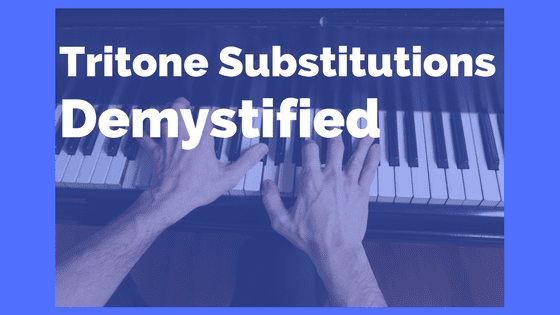Tritone Substitutions Demystified

One of the most common jazz harmony devices is the tritone substitution. If you’re a jazz fan or player you’ve likely heard tritone substitutions many times. But despite the fact that the tritone substitution is often encountered, many students are still uncertain as to what it is, what it does, and how to explain the theory behind it. This article is intended to put all that uncertainty to rest and answer the question “What’s so special about tritone substitutions?”
What is a tritone?
A tritone is an interval of an augmented 4th (or a diminished 5th; the distance between the two notes is six half-steps or three whole-steps). It is the center-point of an octave (splits an octave in two equal halves).
What is a tritone substitution?
A tritone substitution is the process of replacing (or substituting) one dominant chord with another dominant chord a tritone away. For example, if we had an F7 chord, we could replace that chord with a dominant chord a tritone away.
Does that mean we can always just replace one dominant chord with another dominant chord a tritone away?
Theoretically, yes. However, just because you can does not mean that you always should. Substituting one chord for another is going to result in some changes in the sound of the harmony (obviously) and whether or not this is an improvement is up to the user. Of course, expert musicians, orchestrators, arrangers, etc., can use tritone substitutions very convincingly. Other things (like extensions, alterations, and particular voicings) can make the use of tritone substitutions more effective. But to really understand how to use tritone substitutions you must understand the theory that makes the tritone substitution possible.
Why are we able to substitute dominant chords and not other kinds of chords?
In jazz we like to use 7th chords (major 7th, minor 7th, dominant 7th, diminished 7th, etc). Every 7th chord contains a set of guidetones. The guidetones are the 3rd and 7th of any chord.
The guidetones of a chord are what give the chord its quality - i.e., major, minor, dominant. Notice that the root and 5th of the chords below are the same in each example, but the guidetones are different in each, which is what determines the quality of the chord.
Now let’s bring back our earlier example of F7 and B7. Do you notice anything interesting about the guidetones of these two chords?
The guidetones in the F7 chord and the B7 chord are the same (just be sure that you notice that Eb and D# are the same note). Here’s another interesting tidbit - the distance between the two guidetones is… (drumroll, please)... a TRITONE! This is only true for dominant chords and will not work for major and minor chords.
What is the theoretical explanation that makes tritone substitution possible?
We know from studying theory that V-I is a very common, strong resolution (and in jazz we often see another common resolution, the ii-V-I). The dominant chord has tension in its chord tones that creates the sound of being “unstable” and wanting to move, to pull to a resolution. For this reason we say that the “V” chord (the dominant chord) “pulls” to its “I.” The guidetones of the dominant chord are responsible for creating this pull. Look at how the guidetones in a dominant chord resolve by half-step (strong motion) and in contrary motion (also strong motion) to the chord tones of its “I” chord.
Since the tritone substitute of any dominant chord shares the same set of guidetones, this same inherent tension (or “pull”) will exist even after substituting one chord for the other.
Is this all the information I need to start using tritone substitutions in my own playing and arrangements?
Yeah, pretty much. Like everything else in music and life, it takes practice and the more you use it, the more comfortable and better you will become. The first thing to do is to make sure you understand the explanations above. Secondly, start trying to use tritone substitutions as much as possible, even if it means you’re forcing it at times. And thirdly, listening to the masters use these sorts of devices (and transcribing what they do) is invaluable.
Here's a short example of a tritone substitution in the 2nd measure of the jazz classic "Body and Soul" by Johnny Green. In measure 2, the chord sequence is basically a ii-V-I progression in the key of Db major. The original chord changes, beginning in measure 2, are Ebm7 - D7 - Dbmaj7. So, in a way, you can see that the D7 really could be thought of as the tritone substitution for Ab7. The example below puts the tritone substitution of D7 (Ab7) on beat 4, creating motion in the harmony while still maintaining the same function as D7, which is to pull the harmony to the resolution on Db major.








